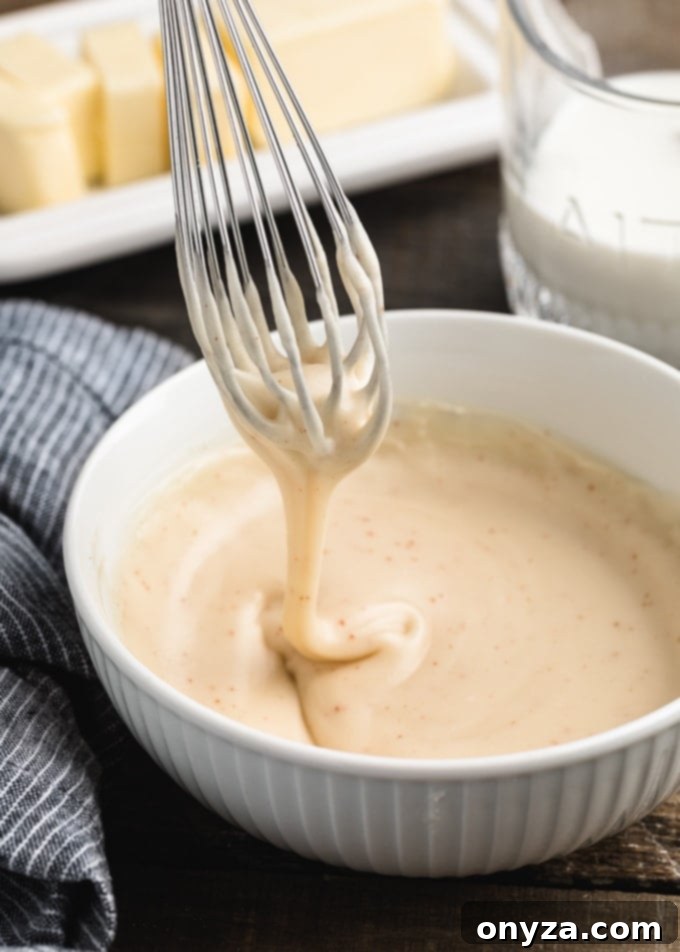Unlock Bakery-Quality Desserts with Easy Brown Butter Glaze
Transform your everyday baked goods into extraordinary culinary delights with this incredibly simple Brown Butter Glaze. Infused with a rich, nutty beurre noisette flavor, this glaze is your secret weapon for elevating any dessert, whether homemade or store-bought. Achieve bakery-worthy results in under 20 minutes!
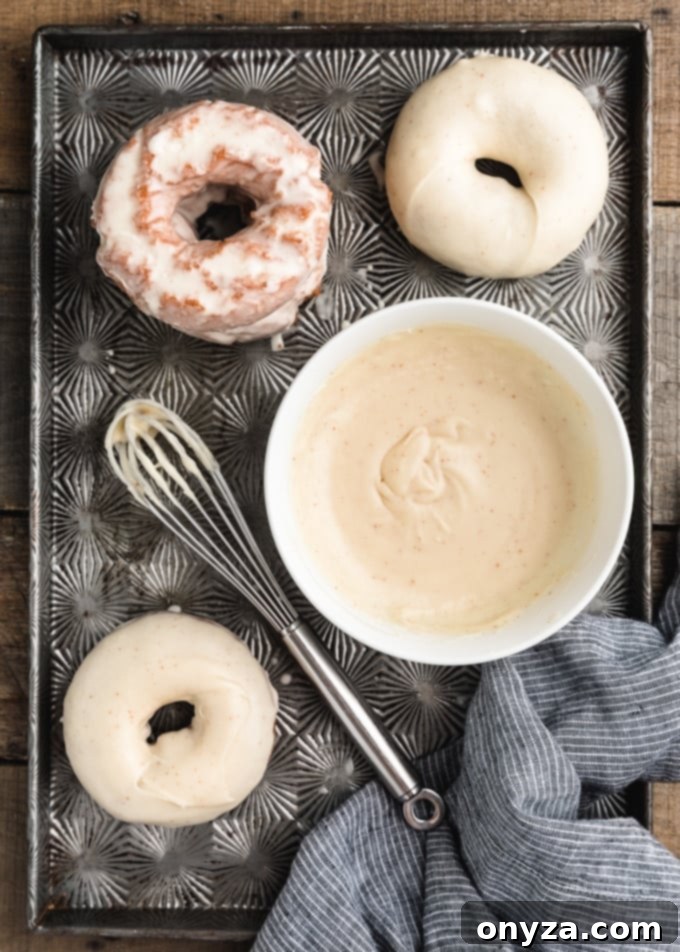
There’s a universally acknowledged truth among bakers and dessert enthusiasts: brown butter is pure magic. Known in French as beurre noisette, this simple ingredient is a game-changer, capable of imparting an unparalleled depth of flavor to countless recipes. If you’re looking to take a butter-containing dish from good to absolutely unforgettable, browning your butter is the first step you should consider. Its rich, toasted aroma and complex, nutty notes are simply intoxicating, and it has a remarkable ability to elevate even the most basic confections.
When this golden elixir is incorporated into a simple sugar glaze, it transforms cakes, donuts, muffins, and quick breads into something truly special. The warmth and complexity brown butter brings to the table beautifully balance the inherent sweetness of a glaze, creating a more sophisticated and deeply satisfying flavor profile. Best of all, achieving this gourmet touch is surprisingly easy and quick, making it a perfect addition to your dessert repertoire.
The Irresistible Allure of Brown Butter Glaze
What makes brown butter glaze so captivating? It all comes down to a process called the Maillard reaction, which occurs when the milk solids in butter are gently cooked until they turn a beautiful golden-brown. This chemical transformation creates hundreds of new flavor compounds, resulting in a distinctively nutty, toasty, and caramel-like aroma and taste. Unlike plain butter, which offers a creamy, straightforward richness, brown butter adds layers of complexity that can complement a wide array of desserts.
Beyond its incredible flavor, brown butter glaze offers practical advantages. It adds a lovely sheen and delicate crust to your baked goods, enhancing their visual appeal. The slight crystallization and buttery richness mean it sets beautifully without becoming overly hard or brittle, allowing for clean slices and easy handling. It’s also incredibly versatile, pairing wonderfully with everything from classic vanilla to autumnal pumpkin and spiced apple flavors. Once you try it, you’ll find yourself reaching for this glaze again and again, eager to impart that irresistible bakery-style finish to all your favorite treats.
Essential Ingredients and Tools for Your Glaze
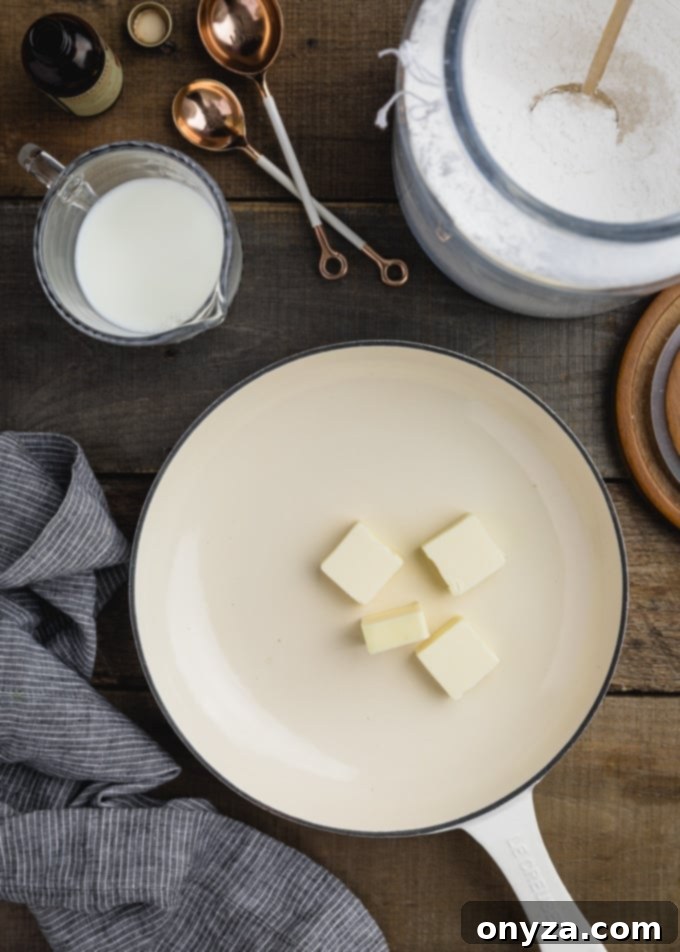
Crafting this remarkable brown butter glaze requires only a handful of pantry staples. Like many of the best recipes, its simplicity belies the incredible flavor it delivers. To whip up a batch of this luscious glaze, you’ll need:
- Unsalted Butter: We recommend unsalted butter to give you complete control over the final salt content of your glaze. If you only have salted butter, simply omit the added pinch of salt.
- Confectioner’s Sugar: Also known as powdered sugar or icing sugar, this finely milled sugar is essential for a smooth, lump-free glaze. Sifting it beforehand is a crucial step!
- Milk or Half-and-Half: A little liquid helps achieve the perfect pourable or drizzly consistency. Milk provides a lighter texture, while half-and-half lends a slightly richer mouthfeel.
- Vanilla Extract: A classic flavor enhancer that complements the nutty notes of brown butter beautifully. Use a good quality extract for the best results.
- Kosher or Fine Sea Salt: Just a pinch is needed to balance the sweetness and truly bring out the complex flavors of the brown butter.
In terms of kitchen tools, you’ll need a few basics that most home cooks already possess: a small, heavy-bottomed pan for browning the butter (ideally a light-colored one for better visibility), a fine-mesh sifter to ensure velvety smooth powdered sugar, a mixing bowl, and a whisk. Having these on hand will make the process seamless and enjoyable.
How to Make Brown Butter Glaze: A Detailed Guide
Creating this exquisite glaze is a straightforward process, broken down into a few easy steps. The key is attentiveness, especially during the butter browning stage, to ensure you achieve that perfect nutty flavor without burning.
Step 1: The Art of Browning the Butter
Begin by browning your butter. While it demands a careful eye, particularly since you’ll be working with a smaller quantity, the process itself is quite simple. Start by cutting your unsalted butter into tablespoon-sized pats. This helps it melt and brown more evenly. Place the butter in a small, heavy-bottomed skillet over medium heat. A heavy-bottomed pan ensures even heat distribution, preventing hot spots that can lead to uneven browning or burning.
For optimal results, choose a skillet with a light interior, such as a stainless steel pan or an ivory-enameled cast iron (like the one shown here). This allows you to easily monitor the color of the butter as it browns. Attempting to judge the subtle color changes in a nonstick or dark-colored pan can be challenging and often leads to over-browning. As the butter melts, it will foam. Once the foaming subsides, continue cooking, swirling the pan frequently. Swirling helps the milk solids cook evenly and prevents them from sticking and burning at the bottom.
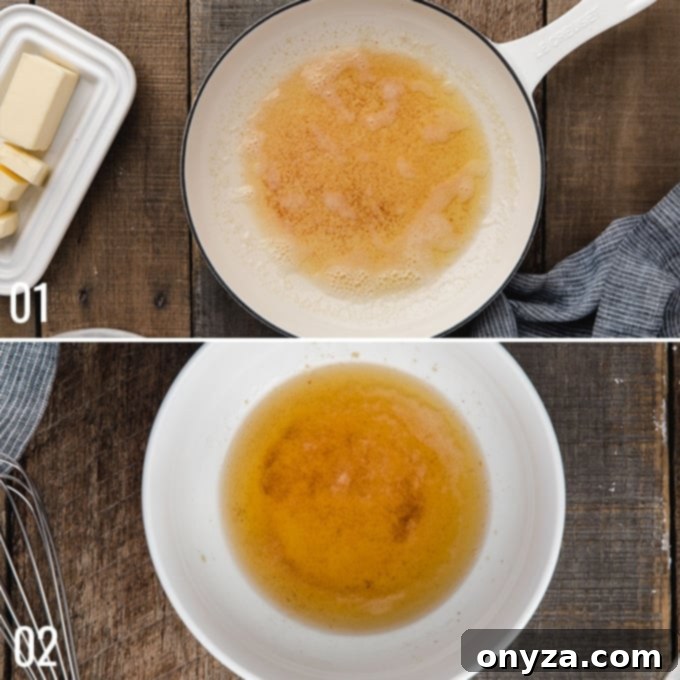
Within just a few minutes, you’ll observe tiny sediments forming at the bottom of the pan. These are the milk solids, and they will gradually begin to turn golden brown. This is the magical transformation occurring! It’s crucial to watch the butter closely during this stage, as perfectly browned butter can quickly become burned butter. The aroma will shift from a standard buttery scent to a rich, toasty, and nutty fragrance, reminiscent of hazelnuts. When it reaches this point, the color should be a deep golden hue, and the milk solids will be a beautiful amber. This is your cue to remove it from the heat.
Immediately and carefully pour the hot brown butter into a separate heatproof bowl. Try to leave behind as much of the darker, more settled sediment at the bottom of the pan as possible. While a few flecks of the toasted milk solids are desirable for added texture and intense flavor, excessive dark bits can introduce bitterness. If you prefer an exceptionally smooth glaze, you can pour the brown butter through a fine-mesh strainer into your bowl. Allow the brown butter to cool for a few minutes while you prepare your powdered sugar.
Step 2: Sifting and Measuring for Smoothness
The secret to an incredibly smooth, lump-free glaze lies in properly preparing your confectioner’s sugar. Sifting the powdered sugar before measuring is a non-negotiable step. This process breaks up any clumps that may have formed in the sugar, ensuring a silky-smooth texture in your final glaze.
For accuracy, especially with dry ingredients like powdered sugar, we recommend the “spoon and sweep” method. Instead of scooping directly with your measuring cup (which can compact the sugar and lead to an inaccurate measurement), gently spoon the sifted sugar into your measuring cups until it overflows. Then, use the straight edge of a butter knife or a similar utensil to sweep across the top, leveling the sugar precisely. This method ensures you get the most accurate volume measurement, which is crucial for the perfect glaze consistency.

Step 3: Mixing the Glaze to Perfection
With your brown butter cooled slightly and your powdered sugar perfectly sifted, you’re just moments away from a sensational glaze. In the bowl with your brown butter, gradually add the sifted confectioner’s sugar and a pinch of salt. It’s best to add the sugar in a couple of additions, whisking thoroughly after each to ensure full incorporation and to avoid a cloud of powdered sugar in your kitchen!
Once the sugar is mostly incorporated, whisk in the vanilla extract. Then, begin adding your milk or half-and-half, starting with one tablespoon and adding more, a little at a time, until the glaze reaches your desired consistency. Whether you prefer a thick glaze for dipping, a medium consistency for pouring over cakes, or a thinner drizzle for delicate finishes, you have complete control. Typically, anywhere from 1 to 3 tablespoons of liquid will suffice. Continue whisking until the glaze is completely smooth and shiny. The result will be a lusciously smooth, aromatic glaze that’s so tempting, you’ll want to dive in with a spoon before it even makes its way to your baked goods!
Optional Flavor Variations: Elevating Your Glaze Further
While the classic brown butter glaze is undeniably delicious on its own, it also serves as an excellent base for exciting flavor variations. Don’t hesitate to experiment and customize it to your personal tastes or to complement specific desserts.
- Spiked Brown Butter Glaze: For an adult-friendly treat, introduce a splash of your favorite spirit. Substitute 1/2 to 1 tablespoon of liquor or liqueur for an equal amount of milk or half-and-half. Excellent choices include rich bourbon, dark rum, or Grand Marnier. The hint of orange in Grand Marnier pairs wonderfully with the nutty notes of beurre noisette, creating a truly sophisticated flavor. Always add gradually and taste as you go to ensure the desired strength and texture.
- Citrus Brown Butter Glaze: For a bright, zesty twist, omit the vanilla extract. Substitute 1-2 tablespoons of fresh lemon juice or orange juice for the milk or half-and-half. For an extra burst of aroma and flavor, stir in 1 teaspoon of finely grated citrus zest (lemon, orange, or even lime). This variation is particularly lovely on lighter cakes or fruit-based desserts.
- Salted Brown Butter Glaze: If you’re a fan of the sweet and savory combination, enhance the saltiness. You can either use salted butter from the start (and then adjust or omit the added pinch of salt) or simply add an additional pinch or two of kosher or sea salt to taste. The salt helps to cut through the sweetness and amplify the complex caramel notes of the brown butter.
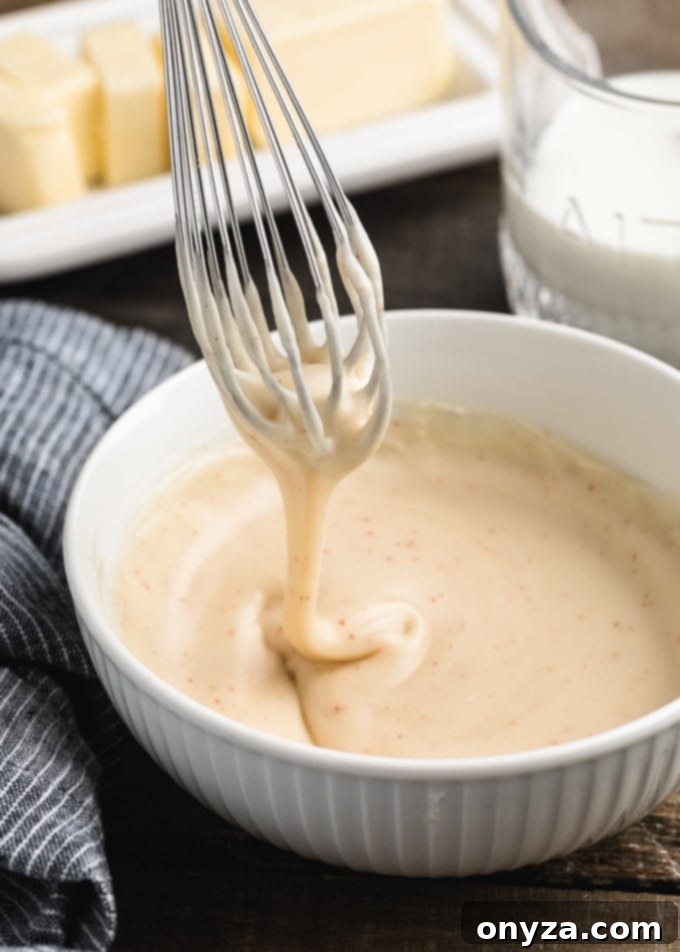
Brown Butter Glaze FAQ
Q. Does Brown Butter Glaze Harden?
A. Yes, this brown butter glaze will set and form a light crust, though it typically won’t become as firm as a basic powdered sugar glaze due to its higher butter content. The butter contributes to a softer, more pliable texture once set. After allowing it sufficient time to firm up (usually 15-30 minutes at room temperature, depending on thickness), the glaze will slice cleanly without excessive stickiness. Most baked goods coated with this glaze can be stacked gently once fully set, but always assess on a batch-by-batch basis, as the exact amount of liquid used can influence the final firmness. If you desire a firmer glaze, reduce the amount of liquid slightly.
Q. Can I Make the Glaze Ahead?
A. Absolutely! Brown butter glaze can be prepared up to 3 days in advance, making it a convenient option for meal prepping or entertaining. To store, simply transfer the glaze to an airtight container and refrigerate it. When refrigerated, the butter in the glaze will solidify, resulting in a much thicker, almost solid consistency. To regain its pourable or drizzly texture, you’ll need to gently warm it. Place the refrigerated glaze in a microwave-safe bowl and heat it in very short increments, about 5 seconds at a time. Whisk thoroughly after each interval, repeating until your desired smooth, pourable consistency is achieved. Be careful not to overheat it; you want it warm enough to be fluid, but not hot.
Q. Do Baked Goods with Brown Butter Glaze Need to be Stored in the Refrigerator?
A. For optimal freshness and to prolong shelf life, especially if storing for overnight or longer, it’s generally recommended to cover baked goods glazed with brown butter and store them in the refrigerator. This is particularly true for items that might spoil more quickly, like those with dairy fillings or very moist cakes. Before serving, allow the glazed treats to stand at room temperature (ideally 72 degrees F or less) for 20 to 30 minutes. This allows the glaze to soften slightly and the flavors of the baked goods to fully develop, ensuring a more enjoyable texture and taste.
Q. Can I use salted butter for this glaze?
A. Yes, you can use salted butter. If you do, we recommend omitting the additional pinch of salt from the recipe initially. Once the glaze is mixed, taste it and add a tiny pinch of extra salt if you feel it needs more to balance the sweetness. Using salted butter will still yield a delicious glaze, though unsalted butter offers more control over the sodium content.
Q. My glaze is too thick/too thin, how do I fix it?
A. Adjusting the consistency is simple! If your glaze is too thick, gradually add more milk or half-and-half, 1/2 teaspoon at a time, whisking well after each addition until you reach your desired consistency. If your glaze is too thin, gradually whisk in more sifted confectioner’s sugar, 1 tablespoon at a time, until it thickens to your preference. Remember to always add ingredients slowly and mix thoroughly to avoid over-correcting.
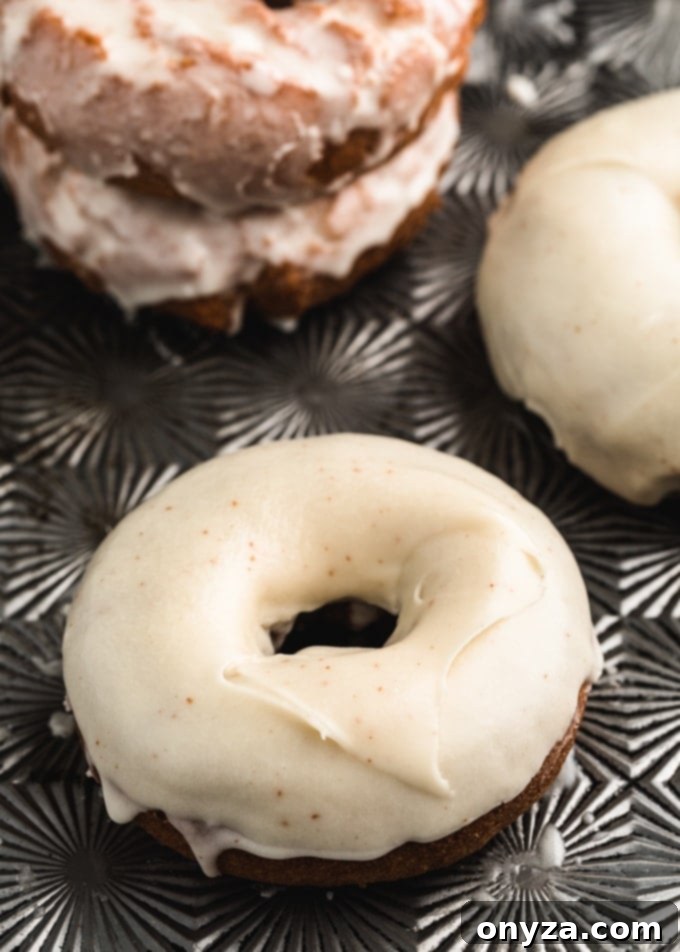
Creative Ways to Use Brown Butter Glaze
The rich, nutty flavor of brown butter glaze makes it an incredibly versatile topping that can elevate a wide variety of baked goods. Its deep, caramel-like notes pair exceptionally well with warm, spiced desserts, making it a favorite for autumn and holiday baking. Here are some of our most cherished ways to incorporate this delightful glaze:
- Bundt Cakes: A simple drizzle or generous pour over a Bundt cake instantly transforms it into a showstopper. It’s particularly fantastic on our Pumpkin Bundt Cake or a delicate Pear Cake, adding a layer of sophisticated sweetness.
- Coffee Cake: Replace a traditional streusel topping or a plain sugar glaze with this brown butter version for an unforgettable breakfast or brunch treat. The nutty glaze complements the spiced cake perfectly.
- Quick Breads: Whether it’s a comforting Banana Bread, a seasonal Pumpkin Bread, or even a zucchini loaf, a ribbon of brown butter glaze adds moisture, flavor, and a gourmet touch.
- Cookies: Dip the tops of cakey cookies, snickerdoodles, or even plain sugar cookies into the glaze for a sweet, toasty finish that elevates their flavor profile. It’s especially good on oatmeal cookies.
- Doughnuts: Move beyond simple cinnamon sugar! Try dipping Pumpkin Cake Doughnuts or classic Apple Cider Doughnuts into this rich glaze for an incredibly decadent and flavorful experience.
- Muffins and Scones: A light drizzle of brown butter glaze turns an ordinary muffin or scone into an elegant pastry. It’s especially delicious on apple, pumpkin, or cranberry variations.
- Cinnamon Rolls: Forget your usual cream cheese frosting! Spread this brown butter glaze over warm cinnamon rolls for a truly indulgent and complex alternative that will have everyone asking for more. The warmth of the rolls will melt the glaze slightly, allowing it to soak in beautifully.
- Pancakes and Waffles: For a weekend brunch special, use a slightly thinner version of this glaze as an elevated syrup. It’s a fantastic alternative to maple syrup, adding a rich, buttery depth.
- Fruit Tarts and Crisps: A delicate drizzle over a baked fruit tart or apple crisp can add a beautiful sheen and enhance the fruit’s natural sweetness with its nutty undertones.
What’s your favorite way to use Brown Butter Glaze? Share your creative ideas and serving suggestions with us in the comments below! We love hearing from our community.
Explore More Easy Cake Glaze Recipes
If you’ve enjoyed the simplicity and deliciousness of this brown butter glaze, you might be interested in exploring other easy-to-make glazes to complement your baking adventures. Expanding your repertoire of glazes means you’ll always have the perfect finish for any dessert.
- Basic Powdered Sugar Glaze: A foundational recipe that’s quick, easy, and endlessly customizable.
- Cream Cheese Glaze: Rich, tangy, and perfect for carrot cakes, red velvet cakes, and spiced muffins.
CRAVING MORE? Don’t miss out on our latest recipes and baking tips! Subscribe to our newsletter today and join our vibrant community on social media. Connect with us on Facebook, Pinterest, and Instagram for daily inspiration and culinary adventures.
Brown Butter Glaze Recipe
This irresistible glaze recipe takes a basic sugar glaze to the next level with the rich, nutty flavor of brown butter. So incredibly good, you’ll want to eat it straight from the bowl!
- Prep Time: 10 minutes
- Cook Time: 10 minutes
- Total Time: 20 minutes
- Yields: 8 servings
Ingredients
- 4 tablespoons unsalted butter
- 1-1/2 cups sifted confectioner’s sugar (powdered sugar, icing sugar), measured using a spoon-and-sweep technique
- Pinch kosher or fine sea salt
- 1 teaspoon vanilla extract (to taste)
- 1-3 tablespoons milk or half and half
Instructions
- Cut butter into tablespoon-sized pats and melt over medium heat in a small, heavy-bottomed skillet. Choose a light-colored skillet (stainless steel or white/ivory enameled) so you can easily monitor the color of the butter as it browns. When the foaming subsides, continue cooking, swirling the pan frequently, until the milk solids turn golden brown and the butter develops a rich, nutty aroma. Watch it closely, as it can burn quickly!
- Immediately pour the brown butter into a bowl, carefully leaving behind as much of the dark sediment in the pan as possible. (For an even smoother glaze, you can pour the brown butter through a fine mesh strainer.) Set it aside to cool slightly while you sift and measure your powdered sugar.
- Gradually add the sifted powdered sugar and a pinch of salt to the brown butter, whisking to combine thoroughly. Whisk in the vanilla extract. Then, add enough milk or half-and-half (1-3 tablespoons) gradually, whisking continually, until the glaze reaches your desired consistency for dipping, drizzling, or pouring over your baked goods.
Notes
Refer to the FAQ section above for detailed instructions on making ahead and storing glazed baked goods.
Variations:
- Spiked Brown Butter Glaze: For an adult twist, substitute 1/2 to 1 tablespoon of your favorite liquor or liqueur (such as bourbon, rum, or Grand Marnier) for some of the milk or half-and-half.
- Citrus Brown Butter Glaze: Omit vanilla extract. Substitute 1-2 tablespoons lemon juice or orange juice for the milk or half-and-half. Stir in 1 teaspoon finely-grated citrus zest.
- Salted Brown Butter Glaze: Use salted butter, or add an additional pinch of kosher or sea salt to taste, to enhance the sweet and savory notes.
Nutrition Estimate
Nutrition information is automatically calculated and should be used as an approximation:
- Calories: 82 kcal
- Carbohydrates: 8g
- Protein: 1g
- Fat: 6g
- Saturated Fat: 4g
- Cholesterol: 15mg
- Sodium: 2mg
- Sugar: 7g
- Vitamin A: 175 IU
- Calcium: 4mg
Nutrition information is automatically calculated, so should only be used as an approximation.
About our recipes
Please note that our recipes have been developed using the US Customary measurement system and have not been tested for high altitude/elevation cooking and baking.
⭐ Like this recipe? Please rate and comment below! Your feedback is greatly appreciated.
